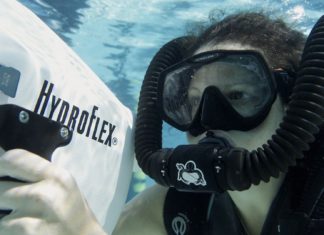
Scuba diving is a very safe sport. It is easy to learn and practice safely. However, accidents can happen. Recklessness and diver error is the cause of most diving-related accidents. This means we should focus on preventing problems before they even happen. We should also learn how to manage problems when they do occur.
So let’s find out what should divers do for their own safety before, during, and after a dive.
Table of contents
- What Should Divers Do For Their Own Safety?
- Respect Your Training Limits
- Respect Your Personal Limits
- Test & Trust Your Equipment
- Use Visual Aids in the Water
- Perform Predive Safety Checks – BWRAF
- Adhere to Safe Diving Practices
- Plan Your Dive, Dive Your Plan
- Maintain Reasonable Fitness
- Diver Readiness
- A Final Word
What Should Divers Do For Their Own Safety?
We are going to assume that a certified diver is asking this question. A lot of uncertified divers may not understand the basic risks of scuba diving and might even be wondering if you need to be certified at all to go scuba diving.
Read More: Do You Need Be Certified to Go Scuba Diving?
“Winging it” and just grabbing equipment with no formal training is definitely not what divers do for their own safety. Therefore, this article will focus on what certified divers should do to keep themselves safe.
Respect Your Training Limits

No matter what level certification you have or how experienced you are, there are limits set by your training. Depth, gas mixes, specialized equipment use, and so forth. Keeping well within your training limits is one key factor for what you should do for your own safety.
For example, Open Water level divers can scuba dive to a maximum of 18m/60ft (according to most dive agencies). If you exceed this depth limit then you will not have the training to deal with new experiences and potential problems, such as Gas Narcosis, that can occur when diving deeper.
Other training limits include gas mixtures, such as diving with Enriched Air (Nitrox) where diving with higher percentages of oxygen has benefits but also dangers alongside it. The same goes for diving with special equipment such as a dry suit or a side-mount setup. You should be training with a specialized professional who can help you see potential problems and how to deal with it in a safe and controlled environment.
Respect Your Personal Limits
Within these agency training limits, you should also set and respect your own personal limits. Do not exceed or push yourself past your comfort level.
For example, you may hold a Deep Diver certification from PADI that allows you to dive to 40m/130ft. However, if you are not comfortable with reaching this depth, then you do not have to. Or if the conditions on the surface make you uneasy, then you should consider aborting the dive and rescheduling for a calmer day.
Know your personal limits and speak to your dive guide prior to the dive. Do not allow your guide or buddy or even yourself to push your comfort level. Setting such limits prevents anxiety which can cause perceptual narrowing. Anxiety and perceptual narrowing is a common cause of accidents where you do not have the capability to manage and solve these problems underwater.
Test & Trust Your Equipment

Scuba diving equipment is a life support system that you depend on to survive underwater for extended periods of time. Diving with unfamiliar equipment can increase this anxiety and mistrust in gear. This is why owning your own dive equipment is preferable to relying on rental equipment.
When you start assembling your own dive kit, it is important that you check it in safe and controlled conditions. For example, you could gear up and jump in a pool to test and ensure your equipment functions as expected and to familiarise yourself with it. In order to further increase trust in your gear, make sure you regularly service your own equipment and maintain it well. Do not attempt to fix diving equipment yourself or to construct makeshift equipment.
If you using rental equipment from a dive operation, then you should check the equipment and do your own checks prior to the dive. This includes checking that the BCD does not leak, testing the inflate/deflate buttons, and smelling and tasting the air from the tank. You should also be checking the scuba tank for its hydrostatic test date, and ensuring it has been visually inspected recently. Checking equipment is very important when ensuring a diver’s own safety.
Read More: Hydrostatic Test and Visual Inspections on a Scuba Tank
Use Visual Aids in the Water
Unfortunately, stories such as these where several divers went missing are quite common. Currents, heavy rain, waves, and low-light can impact how visible you are on the surface. For this reason, it is highly recommended to always carry visual or noise aids for use on the surface. A whistle attached to your BCD is a good idea, and a torch or reflective mirror or strip can make you visible on the surface.
What is a Surface Marker Buoy (SMB)?
Something that divers can do for their own safety is to also carry a Surface Marker Buoy (SMB) on every dive. This is an important piece of safety equipment that you should learn to use during your Open Water course and is a skill you should regularly practice. The SMB acts as a bright marker for boats to see you on the surface. This avoids boats from running over a diver, but also acts as a big visual marker to attract the attention of a boat when needed.

What does a Diver Down flag look like?
In some areas, using a Dive Down flag is a must when diving underwater. If you are wondering what does a diver down flag look like, there are actually 2 flags used in different scenarios.
Diver Flag
Alpha Flag
Read More: What are the two types of Diver Down Flags, and when should you use them?
Perform Predive Safety Checks – BWRAF

As a certified diver, you would have learned how to do predive safety checks, commonly known as a ‘buddy check.‘ There are several steps to the buddy checks so it is common to use an acronym to remember the steps. PADI divers rely on BWRAF to check each other’s BCD, Weight system, Releases, Air, followed by a Final OK before every dive. It is important to continue doing these checks, as a beginner diver, and also as an experienced diver.
Read More: What is the BWRAF Buddy Check?
Adhere to Safe Diving Practices
Safe diving practices are safety standards taught during dive courses and put in place in order to keep divers safe. They are comparable to traffic rules and include practices such as maximum ascent speed, airway and breathing control, safety stops, missing buddy procedures, and so on.
What should divers do for their own safety? They should always follow safe diving practices and not cut corners. Conservative and smart divers will share cool diving stories at the bar. Reckless divers might get away with it a few times, but it will catch up with them.
Plan Your Dive, Dive Your Plan
Planning a dive with your dive buddy or dive group is essential in ensuring everyone’s safety. This is where a group of divers needs to be respectful of others’ personal limits and special needs and requests. Unless divers are certified as Solo Divers or very experienced technical divers, they rely on a buddy system. This means they rely on their buddy for a backup air source, help in case of entanglement, panic, and even surface problems.
Before every dive, there should be a dive briefing. This is a rough plan for the dive so that all divers know what to expect and are on the same page. You should discuss and consider conditions such as current, visibility, temperature, and surface roughness. Are there any other dangers? Marine life to be wary of? Overhead environments? Dive parameters such as maximum depth, dive time, no-decompression limits, and air supply turn points are important to be discussed and agreed on.
Plan your dive. Dive your plan. If it does not go to plan, follow emergency procedures. A very common emergency among new divers is a lost buddy procedure, which can be solved by having a plan and
Read More: How to Give a Great Briefing Before Every Dive
Maintain Reasonable Fitness
Diving is accessible for many ages and fitness levels. There is a medical form before courses to ensure a certain fitness level as well as determine pre-existing medical conditions. There is technically no age limit on the upper end, however, there is on the lower. If you have predisposed medical factors and are an older diver, you can simply plan your dives more conservatively. Always ensure you are well hydrated and nourished.
Read More: Considerations for Older Divers
Common sense also dictates that you should avoid alcohol and drugs before a dive. These things can impair your judgment and lead to diver error and accidents. You should also avoid tobacco as a scuba diver as these can impact your lung’s capabilities over time.
Diver Readiness
Diver readiness refers to how fresh your diving skills and knowledge are. It is a good idea to refresh your skills if you are feeling a bit rusty and out of practice. Not diving regularly means that you might forget important safety procedures. Always ensure you are ready in terms of health, fitness, comfort, equipment familiarity, and diving skills. Often a dive trip starts out with a “check dive” which is a supervised shallow dive to ensure everyone’s skill-level and equipment comfort is up to scratch prior to the day of diving ahead.
Read More: Food to Eat Before a Dive, and What to Avoid.
A Final Word
What should divers do for their own safety you ask? It all boils down to being responsible for yourself and following established scuba diving rules. Rushing dive procedures, peer pressuring others and pushing limits will almost certainly end in disaster. Every diver should be prudent and conservative when it comes to their own safety to ensure that everyone comes back from a dive.




























